
4 Elements: Captain Atom
October 2nd, 2012 by Gavok | Tags: 4 elements, captain atom, freddie williams ii, jt krul, new 5212 months after DC’s problematic reboot made its way onto the scene, we finish the month of getting various #0 issues of DC properties. A couple comics are canceled as of their #0s, which includes the clever use of which in Resurrection Man. For years, that guy’s been wandering around while wondering who he really is and where he comes from and to have his story end in the origin issue is kind of perfect.
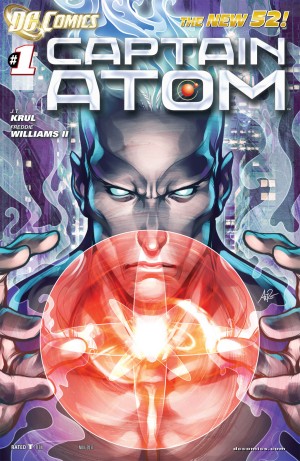
One comic I’m disappointed to see go is Captain Atom by JT Krul and Freddie Williams II. Not at all surprised, granted. In fact, I’m surprised it lasted as long as it did (I had similar feelings about ill-fated comics Azrael and Magog). The series was selling terribly and did even worse than Hawk and Dove, which makes me incredibly disappointed because that means at least two people were buying Hawk and Dove before that got the axe.
I feel Captain Atom got a bad rap and was far better than most gave it credit for. It’s no surprise why. Captain Atom is a bunch of comic book wrongs somehow making a right. That’s excluding Williams, who while there are a couple issues that seem a little too fluid and melty, his art is great stuff. I mean, this is a comic written by JT Krul. That is NOT a name that makes you optimistic. You can reboot continuity all you want, but people will still remember a tripping Roy Harper holding a dead cat and thinking it’s his daughter. The fact that he hasn’t worked on anything notably good since then keeps that red flag flapping.
Then you have Captain Atom himself. Captain Atom is one of those guys who I really want to like, but know it’s a hard sell. He’s pretty boring most of the time. He’s a Superman-level hero without much of a spark. He’s so boring that they’ve given themselves no choice but to try and turn him into a villain three times and all three times it went horribly wrong. There have been times when he’s shown promise. I thought he was the perfect ambassador character to interact with the Wildstorm Universe during Captain Atom: Armageddon. I’ll even say that I didn’t hate his portrayal in the days of Extreme Justice. Judd Winick was able to make something of him in Justice League: Generation Lost but, oops, Flashpoint happened and that character growth no longer matters.
You put a character that’s hard to pull off with a writer who can’t pull off something readable and… you get something good! There’s something inspiring about that. I still won’t buy anything with Krul’s name on it that involves a bow and arrow, but I’ll be a little more open-minded to his future work.
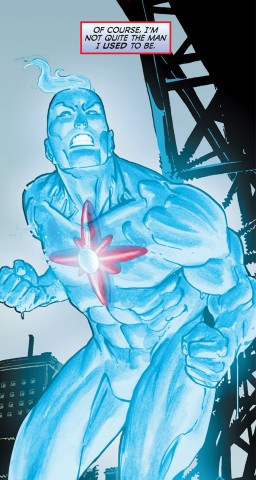
I feel that Captain Atom is the best use of the New 52 concept trying something new. New 52 is essentially DC’s Ultimate Universe, only it’s the new mainstream instead of a parallel. Too many characters are nothing more than a reset button for the sake of telling the same stories, but you have guys like Morrison’s Superman who go in a slightly different direction. Captain Atom strays away from the original concept while holding onto just enough, making him a cross between pre-Flashpoint Captain Atom, Dr. Manhattan and the Sentry.
Air Force pilot Nathanial Adam started acting out after a personal tragedy and got banned from being allowed to fly. He’s handed off to Dr. Heinrich Megala (a supporting character from Atom’s previous DC series), who exists as a wheelchair-bound Stephen Hawking knockoff. A nuclear experiment goes wrong and Adam is obliterated. A month or so later, his body pulls itself back together as a form of pure energy. Now a super-powerful freak of nature with no chance of having a normal life, he wants to at least be able to help people out. At the Continuum facility where he was created, he mainly interacts with scientists Ranita Carter and Scott Alexander. Dr. Carter trusts Captain Atom and acts as a friend while Dr. Alexander considers him a ticking time bomb waiting to go off. Some of that comes from Alexander’s feelings for Carter, which make him protective and even a little jealous.
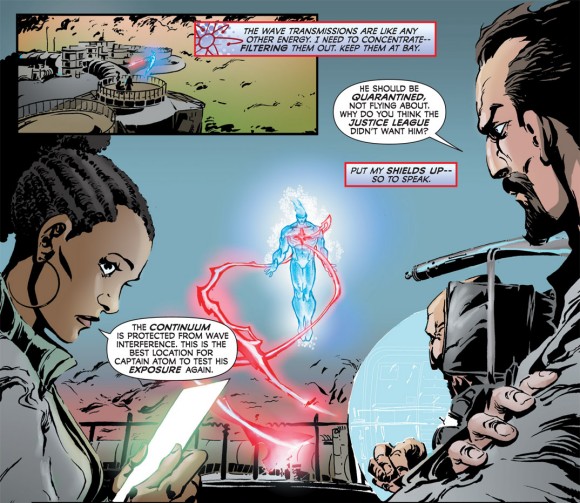
A lot of the enjoyment of the series isn’t so much about the take on Captain Atom, but the take on Dr. Manhattan. With all this Before Watchmen backlash, one of the criticisms I never quite agreed with (though I could see where it was coming from) was the idea that there was nothing left to be said with these characters. Even JMS’s Nite Owl miniseries – which I regard as average at best – tries to expand on the characters’ mental makeup and succeeds somewhat. It’s just that Dr. Manhattan is the exception. There really isn’t much left to be said about him. He’s the complete book of a man. He has a solidified beginning, middle and end and there’s nowhere else to go with it. Dr. Manhattan the character is a barren wasteland of new discovery but Dr. Manhattan the concept is another thing completely.
While Manhattan is a wonderful and deep character, he’s not somebody who lends himself well to an ongoing solo series. It has a lot to do with Jon Osterman, Manhattan’s human self. While compelling, he lacks charisma and conflict. For the sake of exposition, his scientist self plays along with what Manhattan is. He never questions his godly identity or goes against the grain. He simply understands what he is and what he’s capable of. Works great for Watchmen, but there’s plenty of mileage in going elsewhere with it.
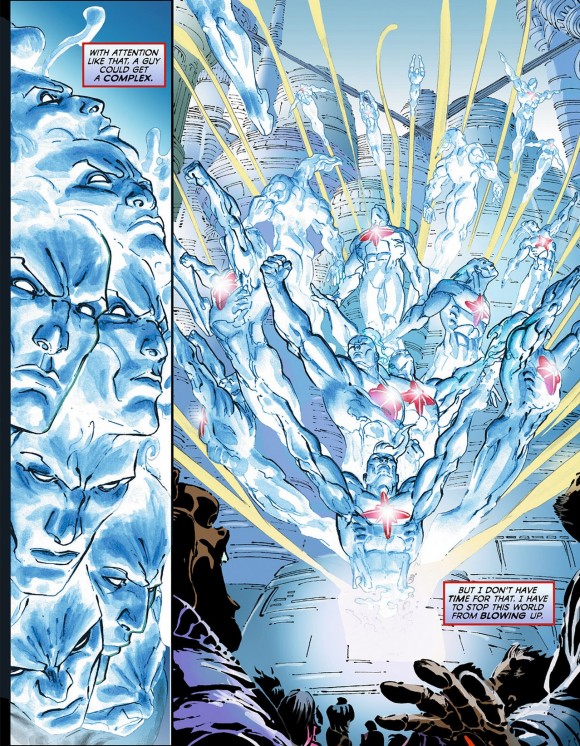
That’s what Captain Atom is. Unlike Osterman, he’s more identifiable to the reader. Not to take away from Osterman’s humanity, but Captain Atom feels more like how the reader would act in these situations, albeit more altruistic than most. He simply doesn’t get what the rules are. That’s what Megala is for. Megala is essentially Osterman watching from the sidelines, acting like Adam’s guide to all the wondrous things he can do. The moody Megala talks about how he feels guilty for what he turned Adam into, but you can also sense a bit of envy when he deals with Captain Atom. He’s ignorant and doesn’t get the potential of what he is. It’s Megala who should have been Captain Atom, damn it! He’s like a kid watching someone else play a video game horribly while not being allowed to take the controls.
With Captain Atom being a Dr. Manhattan who refuses to play by the rules, you get an intriguing look at a good man with far too much power to handle. Captain Atom isn’t Superman-level like he was before Flashpoint. The New 52 Captain Atom is more on the level of someone like the Spectre or the Sentry. He doesn’t have anything close to resembling a rogues gallery because there’s nobody that can mess with him. Sure, General Eiling is always on his case, but he’s more of a nuisance than an actual threat.
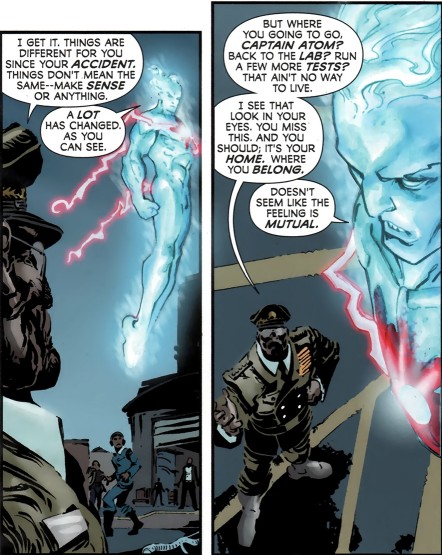
Since Captain Atom isn’t tied up with having to fight archenemies and having conventional superhero adventures, yet also unable to have a normal life nor sleep, that brings up questions on what he should be doing. Top-level heroes usually have limits put in place from keeping them from doing too much. After all, this is a shared universe and we need a status quo. Dr. Manhattan keeps from going too far because he claims he can’t. Superman and Thor claim they won’t. Captain Atom doesn’t see the big deal in it.
Do his good intentions make it right? Maybe, maybe not. For instance, remember that amazing scene in All-Star Superman where Superman convinces a troubled girl not to kill herself? Touching stuff that shows Superman’s compassion. Compare that to Captain Atom simply undoing this girl’s attempt at suicide through pills.
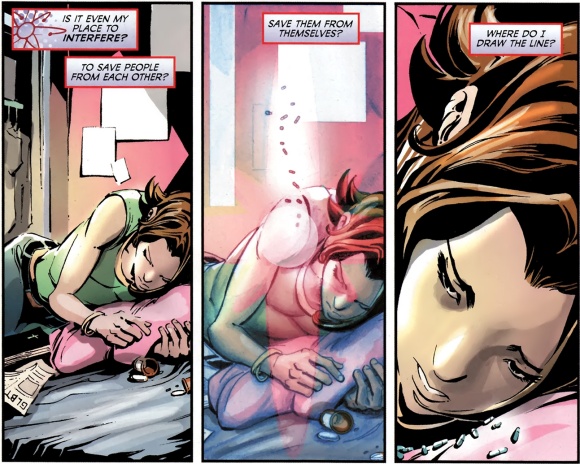
His heart is in the right place, but his actions are sketchy. In the Superman example, he talked the girl down and gave her help. Captain Atom simply decided, “Nope, you don’t get to die,” while at the same time having no presence there. There’s nothing stopping her from trying again and even if she does and he continues to stop her, where does he get off?
The big severity of how Captain Atom carries himself in the grand scheme is when he cures a child of cancer. Curing cancer is one of the biggest taboos in comic books and really fiction in general. It’s the one thing you can never do or it will break the illusion of the story having anything to do with reality. A comic book scientist can create time machines and shrink rays, but when it comes to cancer, all there is is a shrug. The times it does work, it’s a one-time occurrence that would never happen again in a million years. Even Dr. Manhattan is directly affected by the existence of cancer and never makes the slightest gesture to stop it, which he surely must be able to. Well, Captain Atom says, “Fuck your cancer.” Using his power to read electronic information (the guy can actually SEE Twitter in thin air), he hears the “prayer” of a boy with a tumor. Invisible to everyone, he shrinks down and enters the boy’s brain to take it out.

This is still a Big Two comic book, so naturally this can’t stand forever. Something needs to happen to keep Captain Atom from just annihilating all cancer. This is dealt with in the series’ best arc where Captain Atom meets with versions of himself from various points of the future to deal with a paradoxical crisis. The evolution of what he becomes is well-designed, including a 20-years-later Captain Atom who has done away with the muscles and is almost chimp-like as well as a three-headed Hindu deity form.
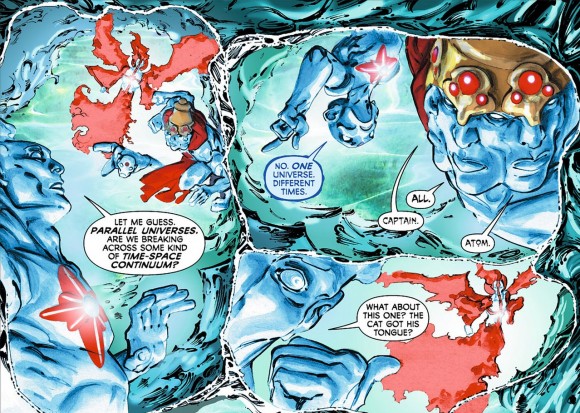
I don’t want to really go further in the explanation too much because I don’t want to spoil, but the discoveries made by Captain Atom bring a logical and satisfying conclusion to this big conundrum of how he can exist in this shared superhero universe unopposed. I have a feeling Krul knew that the series’ time was short and made this story as the planned finale, not realizing that he’d have a couple more issues left. That’s not to say that the latter issues aren’t good, as they too are quite enjoyable and give us a final scene that’s very familiar. Let’s just say that while it doesn’t directly relate with that suicidal girl from earlier, it does show the pitfalls of a man with too much power and not enough control deciding what’s best for others without their consent.
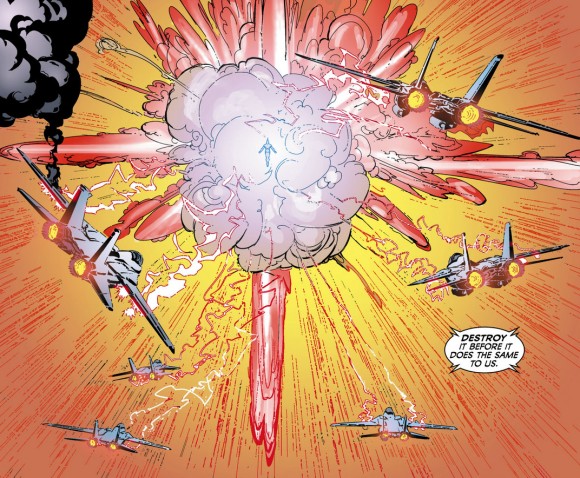
After reading through the series, Captain Atom #0 is rather pointless. It doesn’t add anything we don’t know other than a sense of irony in Nathanial Adams’ reasoning for taking part in Megala’s experiment. Still, I think that if you haven’t checked any of the series out, #0 would make for a good starting point as it doesn’t have the “hit the ground running” flavor that all the #1s had to have in the New 52. Consider it the true first issue that you don’t have to read to understand everything.
If you do want to check out the series, you’d be best with just tracking down the back issues, which shouldn’t be hard since nobody bought them. As of this writing, the first trade hasn’t even come out yet. It won’t be out until December. FIFTEEN MONTHS AFTER CAPTAIN ATOM #1 WAS RELEASED! Jesus Christ, DC!

Finally someone who agrees with me! But there’s something curious about it, i get the feeling this was somehow planned since the JL:Generation Lost times and was refine to work better in the New 52. Also, i was reading some interviews about Krul and he says how he decided, instead of doing another superhero book just doing a science fiction comic and…hell, he is pretty good at it! If he get’s another chance to write another character i hope is science fiction related!
I loved Captain Atom and was thinking of writing something about it myself. You beat me to it! I’d be mad but its a great article.
I was really happy to see this article on 4l. I’ve been saying for a while that Captain Atom is one of the most interesting and underrated New 52 titles, and I was really disappointed when it was cancelled (although not surprised at all).
I wrote this essay a while ago, “Why I Hope Captain Atom Isn’t Cancelled or: How I Learned to Stop Worrying and Love Captain Atom”. This was a month or two before the title was actually cancelled. For some reason, Cap Atom just never got the attention he deserved in the New 52…Krul and Williams did some really great work remaking the character into a sort of mainstream Dr. Manhattan. I wonder why Captain Atom wasn’t included in the government sponsored Justice League of America?
Gavok, I wanted to thank you for your exhaustive work on superhero character histories for those of us who don’t have a clue about them. Your pieces show the advantages of a focused effort over Wikipedia’s confusing summaries that assume junkie status on the part of the reader and segregate the trade history from the character’s adventures. I don’t tend to follow characters across creators, and so this site has been invaluable when I want to know more.
(After watching some clips from the 1988 FA cup final with Vinnie Jones, I typed “Juggernaut” into the search box here and ran across your latest Deadpool article, proving your point in that article about how certain parts of this site keep getting views no matter what.)
If Marvel had its head on straight it would be trying to publish “We Care A Lot” in print and giving you an advance to update it as you saw fit. As someone who no longer really reads superheroes, but did not care at all about comics as a kid until I saw Venom on a Mark Bagley cover? I would buy a hardback edition of “We Care A Lot” the moment it came out.
@Don Druid: Thank you very much, man. Judging from your praise, I think you’re going to love the series of articles I’m doing next.